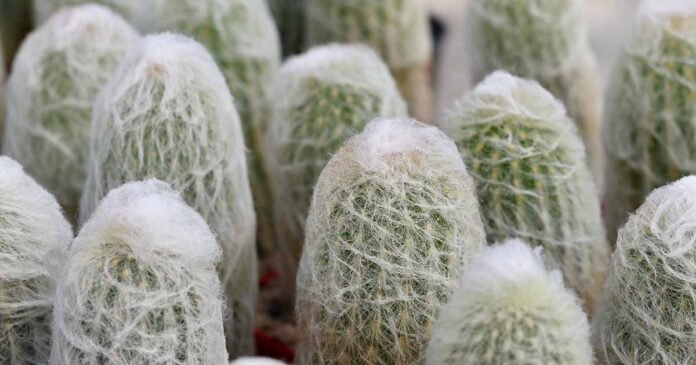Old man cacti are low-maintenance, water-wise houseplants that make eye-catching stand-alone specimens.
They also play well with bromeliads and succulent species that share similar cultural requirements.
If you live in Zone 9 or 10, consider adding old man cactus to your xeriscaping design scheme outdoors.
How to Grow
In its native habitat and in outdoor gardens, C. senilis requires a full sun location and well-draining, sandy soil with a slightly acidic pH between 5.5 and 6.5.
We can mimic these cultural requirements indoors.
Choosing a Container
Start with a suitable pot.
The best container for a desert cactus is made from a porous material like unglazed clay, because this allows moisture to evaporate and prevents oversaturation. One or more drainage holes are essential.
The diameter should be one inch wider than the current size of the cactus.
It’s best to graduate pot sizes as needed rather than starting with an oversize pot because cacti roots prefer to be snug, and planting in too much soil can lead to inadvertent overwatering.
Soil
Along with an appropriate pot, you’ll need to purchase a good quality cactus and succulent potting medium like this one, available from Tank’s-Pro via Amazon in 16-quart bags.
Tank’s-Pro Cactus and Succulent Mix
Tank’s-Pro Cactus and Succulent Mix contains horticultural pumice, coconut husk chips, and organic compost to promote drainage and support nutrition.
We also have directions for making your own cactus potting soil.
As mentioned, when planting in the container of your choice, set the stem at the same depth as in the original container to reduce transplant stress and minimize the risk of rotting.
There should be at least half an inch of “head space” above the soil surface to permit watering without soil runoff.
Light
Choose a south-facing window for optimal daylight exposure – the better the light, the more abundant the hairy spines will be.
Temperature and Humidity
The ideal room temperature during the growing season is in the 65 to 85°F range.
If possible, relocate the pot to a setting with a temperature of 55 to 60°F during winter dormancy.
This desert species is accustomed to dry air, so the lower the humidity, the better.
If summer humidity is a problem in your home, consider running a dehumidifier along with your air conditioner to lower it.
Water
Water using the “dry and soak” method, allowing the soil to dry out completely before you give it a thorough soaking. Use a moisture meter as a guide.


When watering, allow time for the pot to fully drain before returning to its permanent location. Keep the dish below the pot dry to avoid standing water that may result in rotting.
Water as needed during active growth and reduce watering during winter dormancy.
Fertilizing
Per the experts of the University of Minnesota Extension, cacti benefit from a dose of fertilizer in the late spring. A second dose in the summer is optional.
Use a half-strength liquid houseplant food formulated for cacti and succulents. It should contain more phosphorus than nitrogen in the N-P-K ratio.
Miracle-Gro Succulent Plant Food meets the above recommendations. It contains twice as much phosphorus (phosphate) as nitrogen and can be diluted with water.
Miracle-Gro Succulent Plant Food
Miracle-Gro Succulent Plant Food is available from Miracle-Gro via Amazon in a twin-pack of two eight-ounce bottles.
Where to Buy
The quickest way to get started is with a nursery-raised plant. You can generally find this species at nurseries that stock a good selection of succulents.
Start small, and increase the pot size as it matures. Remember to use a towel or gloves during transplanting to avoid being pricked by the spines.
Maintenance
Cacti generally require little maintenance. With this slow-growing species, you will rarely need to repot.


However, if you see roots poking through the pot’s drainage hole, unpot the plant and check to see if the roots are bound or wound tightly around the plant with little visible soil.
When the roots are extremely dense, water penetration and nutrient uptake are poor.
While cacti prefer a tight fit, once the roots fill the pot, it’s best to go up one pot size and refresh the potting soil.
The best time to repot is during winter dormancy, as this causes less stress than it would during active growth.
Find more tips on repotting cactuses here.
Give your cactus a spring shampoo. Airborne dust, age, bugs, and soil splatter from repotting can discolor the radial spines, detracting from their luster. This is an optional task.


Wear gloves and try not to squeeze the sharp central spines beneath the hair.
Add a drop or two of baby shampoo or other mild soap per cup of tepid tap water and mix.
Cut a hole an inch larger than the stem in a plastic food storage or grocery bag.
Bring the cut bag down over the stem all the way to the base to help retain the soil and keep it from becoming soapy during shampooing.




